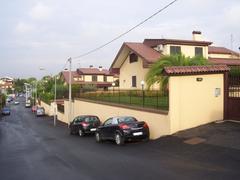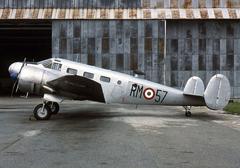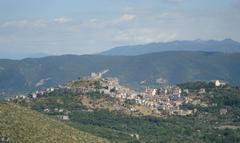
Setteville Visiting Hours, Tickets, and Guide to Historical Sites in Guidonia Montecelio, Italy
Date: 15/06/2025
Introduction: Setteville’s Timeless Appeal
Setteville, a vibrant district within the municipality of Guidonia Montecelio in Lazio, is a destination where ancient heritage and modern Italian life harmoniously intertwine. Nestled just northeast of Rome along the historic Via Tiburtina, Setteville’s roots reach as far back as the 10th century BCE. From its early days as a Latin settlement associated with the legendary city of Corniculum and King Servius Tullius, through its evolution as a medieval rural cluster known as the “Seven Towns,” Setteville has always been a crossroads of history and culture. Today, it offers travelers a unique opportunity to explore archaeological remnants, enjoy authentic local cuisine, and experience the warm hospitality of a thriving community (Summer in Italy; Wikipedia - Guidonia Montecelio).
Serving as a gateway to world-famous attractions such as Hadrian’s Villa (Villa Adriana) and Villa d’Este, Setteville is ideal for those seeking off-the-beaten-path experiences close to Rome. This comprehensive guide covers Setteville’s historical highlights, practical visitor information (including hours and tickets), travel logistics, local events, and recommendations for making the most of your stay (Places and Things to Do; Visit Italy; try-travel.com; mocada.it).
Table of Contents
- Early Origins and Ancient Context
- Medieval and Modern Development
- Setteville in the 20th Century
- Urban Expansion and Community Initiatives
- Practical Visitor Information
- Local Attractions and Highlights
- Dining, Accommodation, and Local Life
- Essential Visitor Tips
- Frequently Asked Questions (FAQ)
- Major Historical Sites in Guidonia Montecelio
- Plan Your Visit: Resources and Contacts
Early Origins and Ancient Context
Setteville’s story begins in the ancient world, with archaeological evidence pointing to continuous habitation from the 10th to 5th centuries BCE. Its strategic location along Via Tiburtina made it a vital hub for trade and cultural exchange during Roman times. The area’s name, reflecting its cluster of Roman villas, hints at the prosperity and social significance Setteville once enjoyed (Summer in Italy).
Medieval and Modern Development
Throughout the Middle Ages, Setteville remained a rural zone under feudal and ecclesiastical influence, with Montecelio as its fortified heart (Wikipedia - Guidonia Montecelio). The agricultural landscape persisted until the early 20th century, shaping the rhythms of daily life and community traditions.
Setteville in the 20th Century
The establishment of a military airfield in 1915 and the creation of the Guidonia Montecelio municipality in 1937 (named after General Alessandro Guidoni) marked the dawn of modernity in Setteville. The district rapidly urbanized, attracting new industries and a diverse population (Wikipedia - Guidonia Montecelio; The Crazy Tourist).
Urban Expansion and Community Initiatives
Post-World War II, Setteville benefited from improved infrastructure, such as the Via Tiburtina and Via Nomentana. While urban growth brought challenges—including infrastructure pressure and environmental concerns (e.g., the “Buca di Setteville”)—local civic efforts like “Il Picchio Laborioso” have revitalized the area, promoting cultural events and environmental awareness (Audiala; Tiburno.tv).
Practical Visitor Information
Visiting Hours and Tickets
- Public Spaces & Markets: Open daily, typically 8:00 AM–8:00 PM; no entrance fees.
- Churches & Outdoor Sites: Free entry, generally open 9:00 AM–6:00 PM.
- Museums & Guided Tours: Tickets usually €5–€15. Check with local tourist offices or official websites for seasonal updates.
- Nearby Major Sites: Hadrian’s Villa and Villa d’Este require separate tickets. Consider combined tickets for savings.
Accessibility and Transport
- By Car: Easy access via A24 and A1 highways; parking available near the main piazza.
- By Train: Guidonia-Montecelio-Sant’Angelo station connects to Rome (Tiburtina) in 30 minutes. Local buses or taxis reach Setteville.
- By Bus: Regular COTRAL services link Rome’s Ponte Mammolo metro station with Setteville.
- On Foot/Bicycle: Setteville’s flat terrain and scenic paths are ideal for walking and cycling (mocada.it).
- Accessibility: Most modern facilities are accessible, but cobblestone streets may challenge those with limited mobility.
Guided Tours and Tips
- Tours: Book through local agencies or tourist offices for historical and cultural itineraries. English-speaking guides are available; reserve in advance.
- Travel Seasons: Spring and autumn are best for mild weather and local festivals.
- Local Events: Check the schedule for the Social Tour Festival in June and other seasonal fairs (Visit Italy).
Local Attractions and Highlights
- Chiesa di San Bartolomeo: A historic church with beautiful frescoes and religious art.
- Roman Villas Ruins: Explore remnants of ancient estates on the outskirts.
- Paolo Di Nella Park: A restored green space ideal for families and relaxation.
- Local Markets: Weekly events featuring regional produce, crafts, and food.
- Nearby: Villa Adriana, Villa d’Este, Villa Gregoriana, Monte Catillo reserve, and the historic center of Montecelio.
Dining, Accommodation, and Local Life
- Dining: Savor traditional Lazio and Roman dishes at trattorie, pizzerias, and agriturismi. Don’t miss homemade pasta, wood-fired pizzas, and local olive oil.
- Accommodation: Choices include B&Bs, rural farm stays (agriturismi), mid-range hotels, and vacation rentals. Book ahead for spring and autumn stays (mocada.it).
- Local Life: Engage with friendly residents at markets, enjoy lively festivals, and explore artisan shops.
Essential Visitor Tips
- Language: Italian is widely spoken; basic English in tourist spots. Learning simple Italian phrases is helpful.
- Currency: Euro (€). Credit cards accepted, but carry cash for small vendors.
- Safety: Generally safe; exercise standard caution with valuables.
- Health: Nearest hospital is Ospedale di Tivoli (10 km); pharmacies are available in town. Use 112 for emergencies.
- Connectivity: Wi-Fi in most hotels and cafés; SIM cards available locally.
- Weather: Spring (15–25°C) and autumn are ideal; summers can be hot, winters cool and quiet.
Frequently Asked Questions (FAQ)
Q: Is Setteville suitable for a day trip from Rome?
A: Yes, with excellent transport links and proximity to major attractions, Setteville is perfect for day trips.
Q: Are guided tours available in English?
A: Yes, though booking in advance is recommended.
Q: When is the best time to visit?
A: Spring and autumn for comfortable weather and festivals.
Q: What are the main historical attractions nearby?
A: Villa Adriana, Villa d’Este, Villa Gregoriana, and the medieval center of Montecelio.
Q: Is Setteville family-friendly?
A: Absolutely—parks, festivals, and safe streets make it ideal for families.
Major Historical Sites in Guidonia Montecelio
Villa Gregoriana
A natural and historical park with waterfalls, caves, and wooded trails.
- Hours: 9:00 AM–6:00 PM (seasonal variations)
- Tickets: ~€5; discounts available
Official Website
Villa Adriana (Hadrian’s Villa)
A UNESCO World Heritage archaeological complex.
- Hours: 9:00 AM–7:00 PM
- Tickets: ~€10; free first Sunday/month
Official Website
Villa d’Este
Renowned for Renaissance gardens and fountains.
- Hours: 8:30 AM–7:30 PM (closed Mondays)
- Tickets: ~€12; combined tickets available
Official Website
Park of the Aqueducts
Open-air park with Roman aqueduct ruins.
- Hours: Sunrise–sunset; free admission
Official Information
Tivoli Cathedral (San Lorenzo)
A historic cathedral open daily; free entry.
Sant’Angelo Castle
Medieval castle and museum; guided tours upon request.
Temple of Hercules Victor
Ancient Roman temple with seasonal access.
Ponte Gregoriano
Historic bridge with scenic views; open year-round.
Villa De Sanctis
Garden villa hosting cultural events.
Historic Center of Guidonia Montecelio
Wander cobbled streets, local markets, and traditional trattorias.
For a full list and visiting information, check Wild Trips Guidonia Montecelio guide.
Plan Your Visit: Resources and Contacts
- Tourist Information: Main piazza or Guidonia Montecelio municipal office (Comune di Guidonia Montecelio)
- Emergency: 112 (police, medical, fire)
- Taxi/Transport: Book locally or through accommodation
- Travel Apps: Download the Audiala app for maps, guides, and local event updates
Summary: Why Setteville Belongs on Your Travel List
Setteville invites visitors to experience Italy’s rich historical layers, from ancient Roman settlements to vibrant modern-day festivals. Its accessibility, welcoming community, and proximity to world-renowned sites make it a rewarding destination for travelers of all interests. Whether you’re savoring local cuisine, exploring archaeological remnants, or joining in the festivities, Setteville promises a memorable and authentic Italian adventure (Villa Adriana Official Website; Villa Gregoriana Official Website; Audiala; Summer in Italy).
Sources and Further Reading
- Exploring Setteville: Visiting Hours, Tickets, and Historical Sites in Guidonia Montecelio, 2025, Summer in Italy (https://www.summerinitaly.com/guide/guidonia-montecelio)
- Wikipedia - Guidonia Montecelio, 2025, Wikipedia (https://en.wikipedia.org/wiki/Guidonia_Montecelio)
- The Crazy Tourist, 2025, The Crazy Tourist (https://www.thecrazytourist.com/15-best-things-guidonia-montecelio-italy/)
- Audiala, 2025, Audiala (https://audiala.com/en/italy/guidonia-montecelio)
- Tiburno.tv, 2025, Tiburno.tv (https://tiburno.tv/2025/02/13/guidonia-buca-di-setteville-via-alla-messa-in-sicurezza-del-monumento-al-degrado/)
- Places and Things to Do, 2025, Places and Things to Do (https://placesandthingstodo.com/guidonia-montecelio-sightseenings/)
- Visit Italy, 2025, Visit Italy (https://www.visititaly.com/what-to-see/lazio/setteville-di-guidonia.aspx)
- Try-travel.com, 2025, Try Travel (https://www.try-travel.com/it/blog/europa/italia/guidonia/things-to-do-in-guidonia-montecelio/)
- Mocada.it, 2025, Mocada (https://mocada.it/blog/setteville-di-guidonia/)
- Villa Adriana Official Website, 2025 (https://www.villa-adriana.net)
- Villa Gregoriana Official Website, 2025 (https://www.parcovillagregoriana.it)
- Audiala App, 2025 (https://audiala.com/en/italy/guidonia-montecelio)


